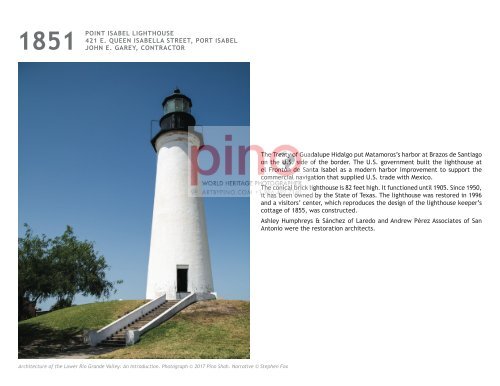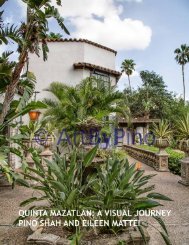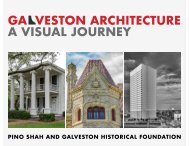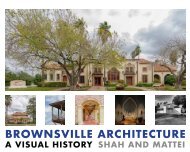Architecture of the Lower Rio Grande Valley: An Introduction
Through photographs, Architecture of the Lower Rio Grande Valley: An Introduction, celebrates the architecture of the Texas-Mexico border region, its craftsmen, its cultures and its climate. The architectural images by Pino Shah provide a journey through 160 years of history and heritage, revealing the border’s built environment as filtered through diverse cultures: Mexican, Spanish, American, German, and French. The photographs highlight the distinctive styles -- Spanish and Mexican Colonial, border brick, Mid-century Modern, Pan American and 21st Century – found in the southernmost region of Texas. These architecturally significant buildings are often culturally and historically significant as well. Pino Shah is a world heritage photographer based in McAllen, Texas and Ahmedabad, India. Stephen Fox is an architectural historian and Fellow of the Anchorage Foundation of Texas provided the narratives for photographs and is as an architectural advisor to the project.
Through photographs, Architecture of the Lower Rio Grande Valley: An Introduction, celebrates the architecture of the Texas-Mexico border region, its craftsmen, its cultures and its climate. The architectural images by Pino Shah provide a journey through 160 years of history and heritage, revealing the border’s built environment as filtered through diverse cultures: Mexican, Spanish, American, German, and French. The photographs highlight the distinctive styles -- Spanish and Mexican Colonial, border brick, Mid-century Modern, Pan American and 21st Century – found in the southernmost region of Texas. These architecturally significant buildings are often culturally and historically significant as well.
Pino Shah is a world heritage photographer based in McAllen, Texas and Ahmedabad, India. Stephen Fox is an architectural historian and Fellow of the Anchorage Foundation of Texas provided the narratives for photographs and is as an architectural advisor to the project.
Create successful ePaper yourself
Turn your PDF publications into a flip-book with our unique Google optimized e-Paper software.
1851<br />
POINT ISABEL LIGHTHOUSE<br />
421 E. QUEEN ISABELLA STREET, PORT ISABEL<br />
JOHN E. GAREY, CONTRACTOR<br />
The Treaty <strong>of</strong> Guadalupe Hidalgo put Matamoros’s harbor at Brazos de Santiago<br />
on <strong>the</strong> U.S. side <strong>of</strong> <strong>the</strong> border. The U.S. government built <strong>the</strong> lighthouse at<br />
el Frontón de Santa Isabel as a modern harbor improvement to support <strong>the</strong><br />
commercial navigation that supplied U.S. trade with Mexico.<br />
The conical brick lighthouse is 82 feet high. It functioned until 1905. Since 1950,<br />
it has been owned by <strong>the</strong> State <strong>of</strong> Texas. The lighthouse was restored in 1996<br />
and a visitors’ center, which reproduces <strong>the</strong> design <strong>of</strong> <strong>the</strong> lighthouse keeper’s<br />
cottage <strong>of</strong> 1855, was constructed.<br />
Ashley Humphreys & Sánchez <strong>of</strong> Laredo and <strong>An</strong>drew Pérez Associates <strong>of</strong> San<br />
<strong>An</strong>tonio were <strong>the</strong> restoration architects.<br />
<strong>Architecture</strong> <strong>of</strong> <strong>the</strong> <strong>Lower</strong> <strong>Rio</strong> <strong>Grande</strong> <strong>Valley</strong>: <strong>An</strong> <strong>Introduction</strong>. Photograph © 2017 Pino Shah. Narrative © Stephen Fox






